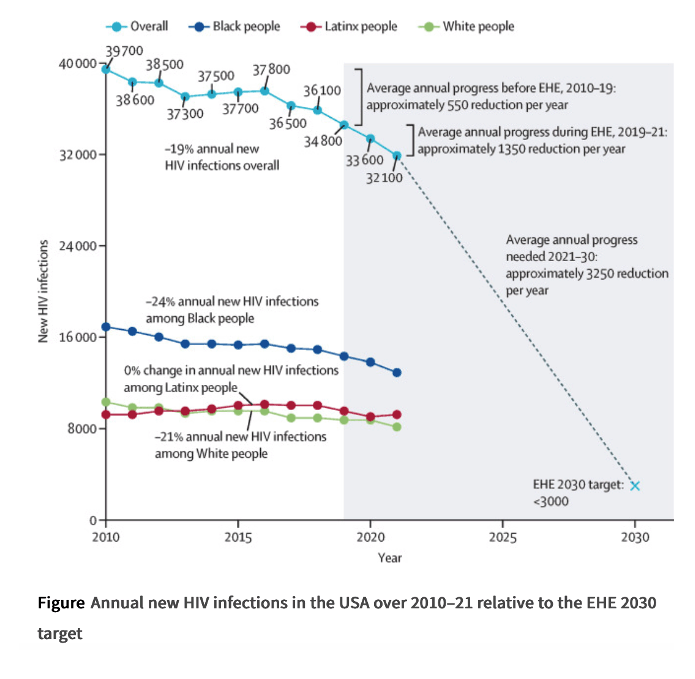| |
Is the USA on track to end the HIV epidemic?
|
| |
| |
Aug 2023
The Lancet HIV
If the EHE 2030 goals are to be achieved, there is a need for broad reprioritisation of health in the USA, including regulatory action and financial investment to ensure equitable access, quality, and outcomes in HIV prevention and care.
Conclusion
Taken together, sizeable investments as part of the EHE initiative have contributed to accelerated progress in reducing annual new HIV infections during 2019-21, even despite substantial disruptions to HIV services during the height of the COVID-19 pandemic.
However, progress has been inequitable, and the available data suggest the USA is still not on track to achieve the EHE's declared 2030 goal-and time is running out. For each additional year in which the target decrease in annual new HIV infections is missed, the path to attaining fewer than 3000 new HIV infections by 2030 becomes narrower. With the tools needed to eliminate HIV transmission in the USA already available, sufficiently accelerating progress in the remaining 7 years of EHE will depend on removing the persistent barriers to equitable reach of comprehensive prevention and treatment in all US communities and populations at risk of acquiring or living with HIV.
If the EHE 2030 goals are to be achieved, there is a need for broad reprioritisation of health in the USA, including regulatory action and financial investment to ensure equitable access, quality, and outcomes in HIV prevention and care.
Additional priority areas for action include improving Medicare infrastructure for the ageing cohort of people living with HIV, 26 advancement of universal health insurance coverage (including Medicaid expansion),27 and integration of comprehensive mental and behavioural health and addiction services with HIV care.
"By 2021, however, the estimated annual HIV incidence had increased by 65% among young Latino MSM and by 67% among young Black MSM as compared with a 5% decrease among young White MSM.3
There are also pronounced HIV inequities among transgender individuals, particularly Black and Latina transgender women, more than one in four of whom are estimated to be living with HIV.8
In addition, approximately one in ten incident HIV infections in the USA in 2021 were estimated to be among people who inject drugs. Estimated annual HIV incidence in this group had declined between 2010 and 2014, but it then reaccelerated from 2014 to 2021, eliminating the previous progress.3
Reducing stigma
Legal, health-care, and interpersonal discrimination remain major challenges for people living with or at risk of HIV, especially people whose identities are subject to intersectional marginalisation based on race, ethnicity, sexual orientation, gender identity, substance use history, or socioeconomic status.
Broadening the HIV workforce
To achieve the necessary scale and reach of prevention and treatment tools, such as HIV testing, PrEP, post-exposure prophylaxis (PEP), and treatment, the workforce delivering these services must be adequately supported and resourced
Mitigating harmful social determinants of health
Inequitable social structures and harmful social determinants of health are increasingly recognised as the underlying drivers of persistent HIV inequities.
Summary
Despite progress in reducing new HIV infections in the USA, publicly available data suggest that new HIV infections continue to occur at an alarming rate. In this Viewpoint, we highlight the regularity with which the existing systems for HIV prevention and treatment delivery in the USA fail and the clearly inequitable effect of the systems’ failure among several priority populations of the Ending the HIV Epidemic (EHE) initiative. Existing data cast doubt on whether the current EHE efforts will suffice to achieve its 2030 goal of reducing annual new HIV infections to fewer than 3000. We outline future directions in four priority areas to regain lost ground in pursuit of the 2030 EHE goals: reducing the stigma affecting people living with and most at risk of HIV; broadening the HIV workforce; mitigating harmful social determinants of health; and recommitting and reinvesting in health in the USA more broadly.

|
|
| |
| |
|
|
|